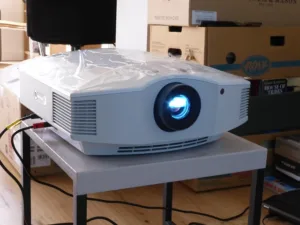I was able to borrow one of Sony’s VPL-HW45ES home cinema projectors in late July (Sony Eases Home Cinema Entry) to conduct a hands-on review. I’ve been interested to test this model since I saw both colour and white light output specified in its documentation, so thanks to Sony for the loan!
The colour light output (or Color Light Output, to give it its correct name) metric was designed to show where some projectors are cutting corners in an attempt to boost Ansi lumen ratings. The reasoning goes thus:
1DLP projectors can artificially raise their brightness levels by adding a white segment to the colour wheel (RGBW). While this increases brightness, it comes at the expense of colour luminance. 3LCD and 3DLP (which do not use a colour wheel) projectors do not need to do this, and in these projectors the output of each colour can be measured separately. White and colour light output are thus much more similar. (the same applies with a colour wheel with just RGB – Man. Ed.)
Sony’s projector uses its own imaging technology, SXRD, a variant on LCoS. However, as SXRD projectors also use three panels (one for each colour), rather than the single device of DLP and so the CLO should be very high.
I was certainly not disappointed. After some irritation getting the projector set up (I am not a home cinema aficionado, so don’t have a separate amplifier or speaker system – I had to plug the projector into a (very) old laptop to get any sound output), I played several different sources: Daredevil, streamed from Netflix; Star Wars Episode IV from a DVD; and my old framerate-testing standby, Mirror’s Edge on the Playstation 3.
Daredevil is a very dark (both in image and content!) show; red is the most prominent colour. It was a great chance to test the dynamic range and contrast of the projector.
Let’s start with the elephant in the room: the HW45ES does not support HDR, which will become more of an issue in the coming years. Daredevil is one of the few shows available in HDR, so it was a shame that the projector didn’t give me the option. However, it is intended to be an entry-level home cinema model, and so the lack of UltraHD, HDR and other assorted features is understandable.
Compared to my monitor (BenQ’s RL2450H), TV or tablet (iPad Mini), Sony’s projector provided a vastly improved picture. The action in Daredevil is often difficult to make out because of the show’s dim lighting, but with the default brightness setting (the unit goes as high as 1,800 lumens) I could differentiate between almost all of the elements of each scene. Black levels were excellent. Unless the projector is being operated in the Batcave, its slightly-lighter-than-black blacks will be indistinguishable from ‘true’ black.
Blacks simply faded from the image border into the dark roomI used Star Wars for more dynamic range tests (the blackness of space), but primarily for colour. Again, the projector performed extremely well: colours were strong without being oversaturated. Several different colour temperatures can be selected, but I used the standard D65 with the default Rec.709 colour space.
Although I did not have the equipment to test it, the out-of-the-box colour accuracy of the HW45ES has been praised by other reviewers. I can attest to the lack of banding or gradations, and the richness of primary colours. Skin tones (this was the digitally remastered edition of Episode IV) also looked natural – something that is harder to do than most people think!
Finally, I used Mirror’s Edge – an older game, now, but a fast-paced one – to evaluate framerate and tearing issues. As expected, there were none to speak of and the source material looked excellent. Again, the bright primary colours made the image jump off of the screen.
A special mention should go to the design of the projector’s remote control. As well as shortcuts to most menu functions (gamma, colour temperature, colour space), the remote also had dedicated buttons to adjust the brightness, contrast and sharpness of the projector – very useful if you are not in the Batcave!

